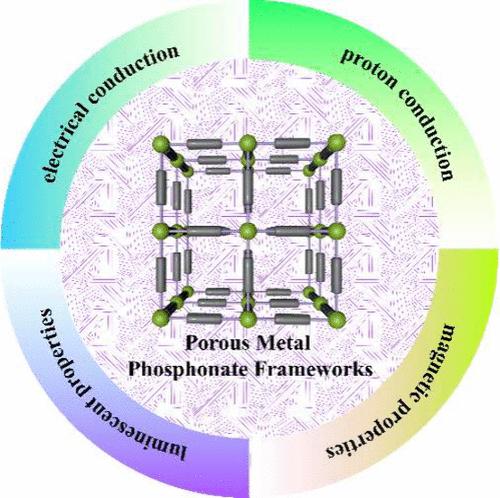当前位置:
X-MOL 学术
›
Acc. Chem. Res.
›
论文详情
Our official English website, www.x-mol.net, welcomes your
feedback! (Note: you will need to create a separate account there.)
Porous Metal Phosphonate Frameworks: Construction and Physical Properties
Accounts of Chemical Research ( IF 16.4 ) Pub Date : 2024-10-07 , DOI: 10.1021/acs.accounts.4c00337 Tao Zheng, Wenzhuo Tan, Li-Min Zheng
Accounts of Chemical Research ( IF 16.4 ) Pub Date : 2024-10-07 , DOI: 10.1021/acs.accounts.4c00337 Tao Zheng, Wenzhuo Tan, Li-Min Zheng

|
Porous metal phosphonate frameworks (PMPFs) as a subclass of metal–organic frameworks (MOFs) have promising applications in the fields of gas adsorption and separation, ion exchange and storage, catalysis, sensing, etc. Compared to the typical carboxylate-based MOFs, PMPFs exhibit higher thermal and water stability due to the strong coordination ability of the phosphonate ligands. Despite their robust frameworks, PMPFs account for less than 0.51% of the porous MOFs reported so far. This is because metal phosphonates are highly susceptible to the formation of dense layered or pillared-layered structures, and they precipitate easily and are difficult to crystallize. There is a tendency to use phosphonate ligands containing multiple phosphonate groups and large organic spacers to prevent the formation of dense structures and generate open frameworks with permanent porosity. Thus, many PMPFs are composed of chains or clusters of inorganic metal phosphonates interconnected by organic spacers. Using this feature, a wide range of metal ions and organic components can be selected, and their physical properties can be modulated. However, limited by the small number of PMPFs, there are still relatively few studies on the physical properties of PMPFs, some of which merely remain in the description of the phenomena and lack in-depth elaboration of the structure–property relationship. In this Account, we review the strategies for constructing PMPFs and their physical properties, primarily based on our own research. The construction strategies are categorized according to the number (n = 1–4) of phosphonate groups in the ligand. The physical properties include proton conduction, electrical conduction, magnetism, and photoluminescence properties. Proton conductivity of PMPFs can be enhanced by increasing the proton carrier concentration and mobility. The former can be achieved by adding acidic groups such as −POH and/or introducing acidic guests in the hydrophilic channels. The latter can be attained by introducing conjugate acid–base pairs or elevating the temperature. Semiconducting PMPFs, on the other hand, can be obtained by constructing highly conjugated networks of coordination bonds or introducing large conjugated organic linkers π–π stacked in the lattice. In the case of magnetic PMPFs, long-range magnetic ordering occurs at very low temperatures due to very weak magnetic exchange couplings propagated via O–P–O and/or O(P) units. However, lanthanide compounds may be interesting candidates for single-molecule magnets because of the strong single-ion magnetic anisotropy arising from the spin–orbit coupling and large magnetic moments of lanthanide ions. The luminescent properties of PMPFs depend on the metal ions and/or organic ligands. Emissive PMPFs containing lanthanides and/or uranyl ions are promising for sensing and photonic applications. We conclude with an outlook on the opportunities and challenges for the future development of this promising field.
中文翻译:

多孔金属膦酸盐骨架:结构和物理性质
多孔金属膦酸盐框架 (PMPFs) 作为金属有机框架 (MOF) 的一个子类,在气体吸附和分离、离子交换和储存、催化、传感等领域具有广阔的应用前景。与典型的基于羧酸盐的 MOF 相比,由于膦酸盐配体具有很强的配位能力,PMPF 表现出更高的热稳定性和水稳定性。尽管 PMPF 具有强大的框架,但在迄今为止报道的多孔 MOF 中,PMPF 的比例不到 0.51%。这是因为金属膦酸盐极易形成致密的层状或柱状层状结构,并且它们容易沉淀且难以结晶。倾向于使用包含多个膦酸盐基团和大有机间隔物的膦酸盐配体来防止形成致密结构并产生具有永久孔隙率的开放框架。因此,许多 PMPF 由无机金属膦酸盐的链或簇组成,这些链或簇通过有机间隔物相互连接。利用此功能,可以选择多种金属离子和有机组分,并可以调节它们的物理性质。然而,受限于PMPFs数量较少,关于PMPFs物理性质的研究仍然相对较少,其中一些仅停留在对现象的描述中,缺乏对结构-性能关系的深入阐述。在本账户中,我们主要基于我们自己的研究回顾了构建 PMPF 的策略及其物理特性。构建策略根据配体中膦酸盐基团的数量 (n = 1-4) 进行分类。物理性质包括质子传导、导电、磁性和光致发光性质。 可以通过增加质子载流子浓度和迁移率来提高 PMPF 的质子电导率。前者可以通过添加酸性基团(如 −POH)和/或在亲水通道中引入酸性客体来实现。后者可以通过引入共轭酸碱对或提高温度来实现。另一方面,半导体 PMPF 可以通过构建高度共轭的配位键网络或引入堆叠在晶格中的 π-π 大共轭有机接头来获得。在磁性 PMPF 的情况下,由于通过 O-P-O 和/或 O(P) 单元传播的非常弱的磁交换耦合,因此在非常低的温度下会发生长距离磁排序。然而,镧系元素化合物可能是单分子磁体的有趣候选者,因为镧系元素离子的自旋-轨道耦合会产生强烈的单离子磁各向异性,并且磁矩很大。PMPF 的发光特性取决于金属离子和/或有机配体。含有镧系元素和/或铀酰离子的自发光 PMPF 有望用于传感和光子应用。最后,我们展望了这个有前途的领域未来发展的机遇和挑战。
更新日期:2024-10-07
中文翻译:

多孔金属膦酸盐骨架:结构和物理性质
多孔金属膦酸盐框架 (PMPFs) 作为金属有机框架 (MOF) 的一个子类,在气体吸附和分离、离子交换和储存、催化、传感等领域具有广阔的应用前景。与典型的基于羧酸盐的 MOF 相比,由于膦酸盐配体具有很强的配位能力,PMPF 表现出更高的热稳定性和水稳定性。尽管 PMPF 具有强大的框架,但在迄今为止报道的多孔 MOF 中,PMPF 的比例不到 0.51%。这是因为金属膦酸盐极易形成致密的层状或柱状层状结构,并且它们容易沉淀且难以结晶。倾向于使用包含多个膦酸盐基团和大有机间隔物的膦酸盐配体来防止形成致密结构并产生具有永久孔隙率的开放框架。因此,许多 PMPF 由无机金属膦酸盐的链或簇组成,这些链或簇通过有机间隔物相互连接。利用此功能,可以选择多种金属离子和有机组分,并可以调节它们的物理性质。然而,受限于PMPFs数量较少,关于PMPFs物理性质的研究仍然相对较少,其中一些仅停留在对现象的描述中,缺乏对结构-性能关系的深入阐述。在本账户中,我们主要基于我们自己的研究回顾了构建 PMPF 的策略及其物理特性。构建策略根据配体中膦酸盐基团的数量 (n = 1-4) 进行分类。物理性质包括质子传导、导电、磁性和光致发光性质。 可以通过增加质子载流子浓度和迁移率来提高 PMPF 的质子电导率。前者可以通过添加酸性基团(如 −POH)和/或在亲水通道中引入酸性客体来实现。后者可以通过引入共轭酸碱对或提高温度来实现。另一方面,半导体 PMPF 可以通过构建高度共轭的配位键网络或引入堆叠在晶格中的 π-π 大共轭有机接头来获得。在磁性 PMPF 的情况下,由于通过 O-P-O 和/或 O(P) 单元传播的非常弱的磁交换耦合,因此在非常低的温度下会发生长距离磁排序。然而,镧系元素化合物可能是单分子磁体的有趣候选者,因为镧系元素离子的自旋-轨道耦合会产生强烈的单离子磁各向异性,并且磁矩很大。PMPF 的发光特性取决于金属离子和/或有机配体。含有镧系元素和/或铀酰离子的自发光 PMPF 有望用于传感和光子应用。最后,我们展望了这个有前途的领域未来发展的机遇和挑战。






























 京公网安备 11010802027423号
京公网安备 11010802027423号